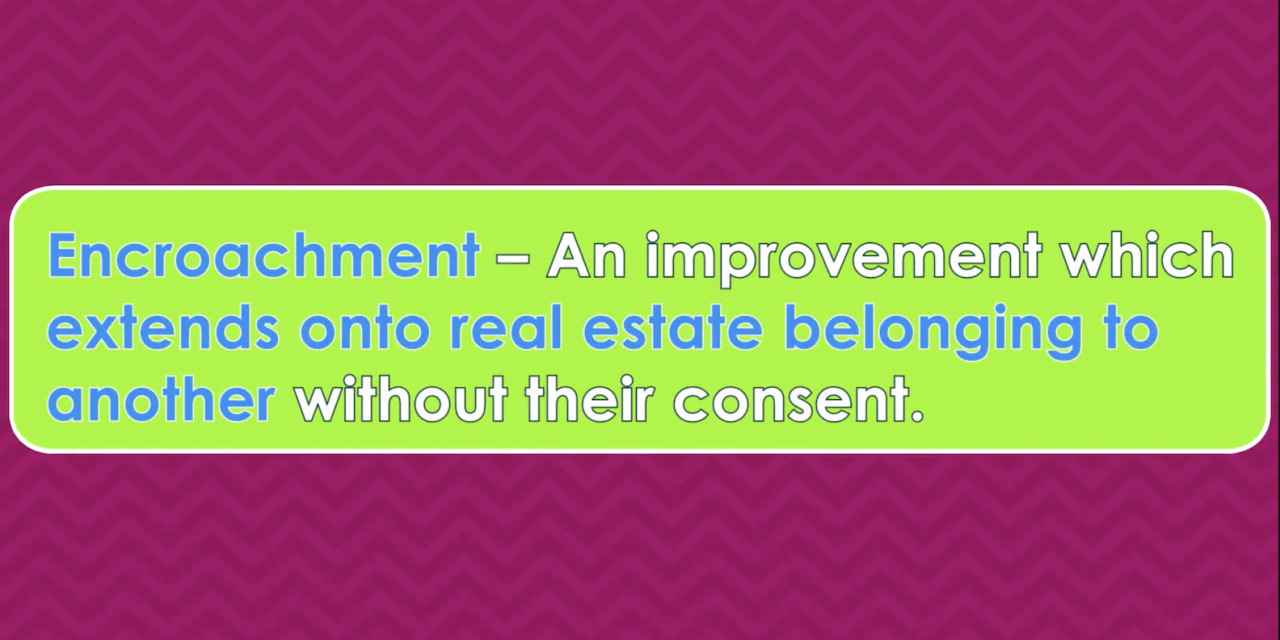What is an encroachment?
An encroachment is an improvement on real estate which extends onto real estate belonging to another person without their consent. Encroachments frequently take the form of a:
- building;
- fence;
- driveway; or
- tree.
The concept of an encroachment is closely related to trespass, nuisance and boundary disputes. All involve an interference with another person’s property rights.
An encroachment qualifies as a nuisance. Nuisance is broadly defined as any obstruction of another’s use and enjoyment of their real estate.
An encroachment also constitutes a trespass when it actually rests on the ground of the neighbor’s property.
Regardless of the name used to describe interference, an owner is entitled to prescribed remedies for the unauthorized interference with their property rights.
When an encroachment has been determined, the remedies available to the owner include:
- an injunction ordering the removal of the encroaching structure; or
- money losses for the diminished value of the property.
Drawing the line
All that is needed to establish the existence of an encroachment is a survey locating the property line. If an improvement on one parcel extends over the line onto an adjacent parcel, it is an encroachment.
Occasionally, neighboring owners disputing the existence of an encroachment rely on contradictory surveys to establish the property line. If the owners cannot agree on the location of the property line, the boundary dispute is to be resolved before any remedy of the encroachment can be granted.
Balancing the hardships
An owner is entitled to terminate or prevent an unauthorized intrusion onto their real estate. However, when a building or other substantial improvement encroaches on an owner’s property, the neighboring property owner’s cost of removing the encroachment may far exceed the damage inflicted on the owner burdened by the encroachment.
Thus, the encroachment is allowed to continue and the owner is awarded money losses for the lost use of their property, called balancing hardships or balancing equities.
The conditions for balancing hardships – i.e., merely granting money losses and allowing an encroachment to continue – are:
- the owner of the property affected by the encroachment may not suffer an irreparable injury due to the continued existence of the encroachment;
- the neighbor who owns the encroaching structure needs to have acted innocently and in good faith; and
- the cost to the neighbor of removing the encroachment needs to greatly exceed the damage done to the owner. [Christensen Tucker (1952) 114 CA2nd 554]
The encroachment easement
When the continuance of an encroachment on an owner’s property is allowed, the encroaching neighbor is granted an equitable easement to maintain the improvement on the owner’s property.
Further, the neighbor needs to compensate the owner for the rental value of the lost use of their property. The easement lasts for the lifetime of the encroachment.
Limitations and delay
An owner seeking to terminate an encroachment or recover money is subject to a three-year statute of limitations running from the commencement of the encroachment. [Bertram v. Orlando (1951) 102 CA2nd 506]
The limitations period for an encroachment is the same as for a permanent nuisance since the damage to the owner is complete and certain as soon as the encroachment is created.
The limitations period runs from the creation of the encroachment, not its discovery. Whether or not an owner has knowledge an encroachment exists does not affect the statute of limitations. [Castelletto v. Bendon (1961) 193 CA2nd 64]
However, where damage resulting from an encroachment is progressive over time, the three-year statute of limitations does not apply from the date of creation.
For instance, an owner’s building is damaged when a neighbor’s building leans on it, due to a poorly compacted fill. The degree of the tilt, and the resulting damage, increases steadily over time.
More than three years after the damage commences, the owner seeks to recover money losses from the neighbor. The neighbor claims the owner is barred from recovering money losses due to the running of the three-year limitations period.
Here, the intrusion on the owner’s building is continuous and progressive – a further intrusion. As with a continuing nuisance, a new claim accrues each time the loss increases. Thus, while the three-year statute of limitations does apply, it does not begin to run on the commencement of the encroachment, but runs from the date on the last increase in damage from the progressively increasing encroachment. [Kafka v. Boxio (1923) 191 C 746]
In addition to barring relief due to the statute of limitations, an action seeking money losses or an injunction against an encroachment can be barred by the equitable doctrine of laches, also called prejudicial delay or detrimental reliance.
A property owner loses their right to enforce the removal of an encroachment or recovery money against the encroaching neighbor if the owner delays in making the claim, causing the neighbor to rely on the owner’s acquiescence to their detriment.
History behind the word
Encroachment originally comes from late Middle English meaning to “obtain unlawfully, seize.” It was formerly also known as incroach. The word also has Old French origins from encrochier meaning to “seize, fasten upon.”


















